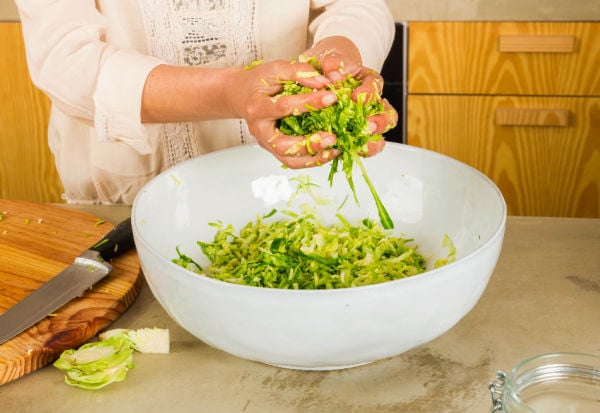Welcome to sauerkraut 101! This is a place to learn everything about making healthy and deliciously sour fermented cabbage at home. Our kimchi guide attracted a lot of interest, so we decided to break down the topic of sauerkraut.
Ready to learn one of the easiest DIY projects in the kitchen? Okay, let’s find out how to make sauerkraut the easy way.
Homemade sauerkraut recipe
Follow these easy step-by-step instructions to make crunchy, tangy sauerkraut that’s way better than store-bought brands. You don’t need a crock or any expensive equipment so let’s get this small-batch food project rolling.
Makes: 1½ quarts. Preparation time: 10 minutes. Waiting time: 2-3 weeks
Recommended equipment:
- Large mixing bowl
- Knife and chopping board
- Ziplock bag filled with salted water
- 2-quart jar
- Optional upgrade: Make life easy with a budget-friendly Fermentation Kit from Amazon that makes the fermenting process failsafe.
Ingredients
- 1 firm green cabbage (about 3 pounds)
- 1½ Tbsp coarse sea salt
- 1 tsp caraway seeds
Method
Step 1: Prep the cabbage
Remove any limp or wilted leaves for the cabbage and discard. You can also keep a leaf to use as a cover over the fermenting cabbage. It is useful for keeping the vegetables from getting air exposure.
Slice the cabbage into quarters on a chopping board, then remove the core. Halve each quarter by slicing them lengthwise, so that you have eight chunks. Finely slice each one crossways to create thin cabbage strips.

Step 2: Salt and season the cabbage
Add the cabbage to a large bowl and sprinkle the salt over the top. Mix with your hands until the salt is well distributed then continue massaging the mixture for another five to ten minutes. The cabbage is ready when it has softened and become watery.
Sprinkle the caraways seeds over the cabbage mixture and mix it through with your hands.

Step 3: Jar the sauerkraut
Use your hands to pack the sauerkraut into the jar, firmly pressing it down as you go. Any leftover juice in the bowl is a salty brine that assists the fermentation process so be sure to pour that over the top.
Fill a suitably sized zip-lock bag with water and a tablespoon of salt. Seal the bag securely, then place it in the jar, so that its weight keeps the cabbage leaves submerged. Leaves that are exposed to air may develop mold, so this is an important step.
Cover the top of the jar with a cloth and wrap around a rubber band to secure it. A length of string will also work fine. This cover will keep out unwanted foreign objects while allowing airflow.

Step 4: Fermentation
Position the jar in a cool, dark place such as a cupboard and allow the sauerkraut to begin fermenting. Check it every day to make sure no cabbage is above the liquid. If necessary, push any leaves under and reapply the cloth.
After two weeks sample a little to see if it tastes ready. It could take over three weeks, especially in colder climates. Once you are happy with the flavor, screw on the jar’s lid and store refrigerated until needed.
The ideal temperature for fermenting sauerkraut is 65-75°F (18-23°C)
Recipe Notes
To adjust the batch size, simply maintain the salt to cabbage ratio and use a smaller or larger jar. You may need to use a fermentation crock or some larger container for big volumes. Allow extra fermentation time for larger batches.
Avoid fermenting in hot areas of the house as it can affect the final flavor and texture. If the room is cooler than the target range for fermentation then it won’t affect the quality, but the process will take longer.
It is normal to see bubbles rising up during fermentation and you may also see foam on the top, which can be scraped off. If you discover bits sticking out of the water with mold growing on them, break the affected pieces off and discard. The rest of the sauerkraut should be fine.
Tips for making perfect sauerkraut
Keep it clean: The beneficial bacteria that are a by-product of fermentation are more likely to thrive in a clean environment. Wash and rinse anything that’s going to touch the cabbage, including the jar and your hands.
Watch closely on day 1: Over the first 24 hours, check the sauerkraut every few hours if you have time. Each time, push the cabbage down to help it compact and soften.
Add liquid: After a day, if the cabbage is still poking above the water, combine a cup of water with a teaspoon of salt. Pour enough liquid into the jar to ensure the cabbage is covered.
Choose fresh ingredients: Selecting only the freshest vegetables to get the best-tasting sauerkraut. We also suggest using room temperature produce rather than refrigerated to avoid getting seriously cold hands.
Squeeze hard: Fermentation won’t help much with the texture, so you need to get the cabbage to a sauerkraut texture using your hands. Massaging the cabbage and salt is the hardest part but doing the job well will produce much better sauerkraut.
Don’t hurry the process: Allowing the cabbage to ferment for longer will result in sauerkraut with better flavor. So, if it’s tasting good after a few days, think what a few more days will do.
Use salt: There’s a time and place for reducing your salt intake, this isn’t one of them. Salt plays an essential role in helping with flavor and texture while enhancing the sauerkraut's shelf life. While cheap table salt should be avoided, you’ll do well to use coarse sea salt.

How long does sauerkraut take to ferment?
Small batches of sauerkraut may be ready to eat within 5-7 days. However, this short timeframe will rob your food of beneficial probiotics. Cabbage fermented for less than 14 days will have three times fewer bioactive compounds compared to a batch fermented for 2-3 weeks.
If you’re more interested in whether the sauerkraut tastes good, then use your senses to test. It should have a subtle vinegar aroma and a pleasant sour taste.
People that are serious about sauerkraut making can invest in pH strips. An acidity level of 3.8 to 3.9 means your pickle is ready.
- Larger batches of sauerkraut take longer to ferment than smaller ones.
- Warmer temperatures ferment food faster than cooler temperatures.
Can anything go wrong making sauerkraut?
Making sauerkraut at home is one of the simplest DIY projects you can undertake. In most cases, people find that making pickled cabbage rarely fails. In saying that, here are a few pointers:
- Fermenting sauerkraut for too long can result in mushy cabbage that doesn’t taste good.
- Using too little salt can result in veggies that lack crunch.
- Temperatures that are above the recommended zone can produce limp vegetables or vinegary, acrid sauerkraut.
- If your kraut is green, pink, or verging on black then discard it without taste testing.
- A little fuzzy mold on top can be removed and the rest should be safe to eat.
How to store sauerkraut
Sauerkraut can be stored in the refrigerator for 4-6 months in an airtight container. It is important to use a clean spoon every time you use it to avoid cross-contamination. If you detect an acrid smell or the cabbage tastes unpleasant then discard immediately.
For longer-term storage outside of the fridge, consider canning the kraut, although all the gut-friendly bacteria will be killed.
Another safe way to store sauerkraut long-term is to freeze it. This method of storage also kills the probiotics, but the kraut will last 8-12 months.
Culinary uses
Sauerkraut is a versatile pickle that adds delicious acidity and tang to any dish. Its classic use in Germany is topped onto brats, but many also enjoy slathering some onto sandwiches like Reubens. Salads, pasta, eggs, burgers, and grain bowls all benefit from a little kraut.

Best equipment for improving your sauerkraut
Are you ready to level up your sauerkraut process? Check out this dedicated equipment that’s used by the experts. They’ll improve the final product and make the whole process maintenance-free.
Airlock lids: If you want to prevent yeast and mold spore growth on the surface area of your sauerkraut then an airlock lid is an excellent solution. It releases air pressure during fermentation without allowing the nasties in.
Sauerkraut tamper: Not as useful as an airlock lid, but these stainless steel or wood pounders are beneficial. They can be used to release liquid from the cabbage and to stuff the vegetables into the jar. Check out the Masontops Pickle Packer from Amazon for a reliable, sturdy tool.
Crocks: A nonreactive crock is ideal for fermenting food. They come in a range of sizes so think about how much you’ll be producing before choosing a size. Crocks are super-helpful as they come with weights and an airlock device that keeps oxygen out of the vessel.
If you’re serious about sauerkraut making, then crocks are a sensible investment. The Kenley Fermentation Crock is our pick based on performance, included extras, and price.
Other food projects for you to try:
How to preserve herbs when you've got too much.
Ice cream making at home for beginners.
Cheddar cheese making at home.
Commonly asked questions
What does sauerkraut taste like?
Sauerkraut has a sour, acidic flavor with a crunchy texture. Compared to similar pickles like kimchi, it is much milder and will appeal to a wider number of people. Its tangy taste is perfect for balancing out fatty meats like sausages and pot roasts.
What’s the difference between sauerkraut and kimchi?
While they both are made by pickling cabbage, sauerkraut has a longer fermentation, resulting in a more acidic, less salty flavor. Kimchi is a more complex, spicier flavor thanks to the addition of gochujang paste and a slew of additional spices and vegetables.
Can I make salt-free sauerkraut?
Although you’ll find recipes for making sauerkraut without salt, we strongly recommend adding it. It is a key ingredient, assisting with producing lactobacillus bacteria while helping prevent unwanted bacteria. It also helps extend shelf life, while improving flavor and keeping the vegetables crisp.
Is sauerkraut good for you?
Fermented foods like sauerkraut are considered very healthy by health experts. They are high in live microorganisms that assist with digestion while being high in vitamins B6 and K, folate, thiamin, and riboflavin.
How much salt is needed to make sauerkraut?
Salt should make up around 2-3% of the content. That means you’ll use two teaspoons of salt for every pound of cabbage. Unlike some baking recipes that require precise measurements, adjusting the levels of salt won’t ruin the sauerkraut.
Summing up
If you’re new to the world of pickling, then sauerkraut is a great place to start. It’s easy to make and you can get by without specialized equipment.
There are no hard and fast rules when it comes to vegetable choice. Any variety of cabbage will work fine, such as a red, green, or napa cabbage. You can add other types of vegetables or even fruit. Apple is delicious as it adds sweetness.
Happy kraut making!

Leave a Reply